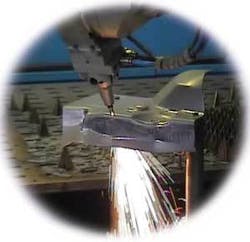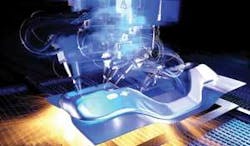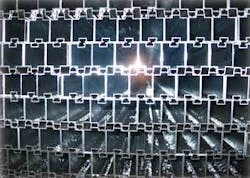Big benefits from easy programming of complex laser path
Terry Antrobus
The implementation of multi-axis simultaneous laser cutting machinery is becoming increasingly common among manufacturing organizations around the globe. These complex and versatile machine tools, long established for use in the aerospace and automotive engineering sectors, are becoming standard equipment for many small- to medium-size precision and contract shops.
FIGURE 1. Five-axis laser cutting enables Ilford Engineering to process complex components for the automotive industry.
This highly productive equipment can be broadly grouped into two distinct areas: machines for applications such as trimming and cutting apertures on pressed or drawn 3D components or laser drilling holes on turbine components and those specifically designed for the cutting of tube components-round and non-round tube sections, non-linear tubes, and pre-formed tube. Many of the former also have secondary rotary axis attachments, which enable the machining of parts requiring rotational moves during machining.
Recent machine tool developments require the total transformation of these two programming functions, with the capability of 3D 5-axis cutting but with an ability to cut in ‘tube mode’ as appropriate. Small-footprint machines are being implemented within micro-scale component manufacturing applications such as those for medical technology device manufacture.
Fast moving machinery
With all of those ‘degrees of freedom’ and with the added likelihood of damaging and costly collisions, and the need for accuracy in laser path, all of this hardware takes a good deal of programming and controlling.
CAM software has made rapid advances over recent years for these technologies. For example, the PEPS SolidCut suite from Camtek is easing the workload, delivering significant gains in productivity and time saving for increasing numbers of programming staff and production managers around the world. This solution comprises two modules for 3D/3-5 axis programming and 3-6 axis tube applications.
FIGURE 3. Processing 13-meter-long tubes is manageable with the right software.
Several global examples of successful implementation of multi-axis programming illustrate the benefits companies have experienced.
In Basildon (Essex, UK) Ilford Engineering, a supplier of high-precision parts for the automotive industry, installed a Prima Rapido 5-axis laser cutter because companies such as Lotus and McLaren were demanding more complex components. The company had previously been subcontracting this work out. The laser software CAD/CAM system it selected was PEPS SolidCut, chosen for functionality and cost. Among the many benefits of the software are improvements in simulation. Rob Blackwell, head programmer, said this feature was in advance of anything he tested elsewhere, pointing out that this version was even able to show feedpipes in one application. The Rapido laser cutter with PEPS SolidCut has drastically increased the types of parts that Ilford (www.ilfordengineering.co.uk) can manufacture in-house (see Figure 1).
On the other side of the world, in Melbourne, Australia, Laser 3D (www.laser3d.com.au), a 15-year-old laser job shop with 40 employees, operates 13 laser cutting systems supplied by Laser Lab (8), Cincinnati, and TRUMPF (4). The company supplies formed metal and plastic components predominantly to the auto industry for clients such as Ford, Toyota, and General Motors Holden (see Figure 2). Work is produced in two job shops, which give the company the ability to provide a broad range of laser cutting and welding services. With an expanding array of laser cutting machines for its increasing metal cutting requirements, Laser 3D had to deal with the issue of programming them more effectively.
Managing Director Brian Finn says, “We were looking for possible ways to improve our response time and accuracy for 5-axis cutting.” For example initial programming on the LaserLab system was by teaching, production of fixtures was slow and programs were not accurate enough so machine time was wasted. The company bought PEPS SolidCut Laser for the LaserLab and TRUMPF machines and, among other benefits, realized huge time savings (up to 80 percent) in the design and building of fixtures, 50 percent less setup time than manual teaching, and accuracy improvement.
Laser 3D plans to expand its existing plant. Finn says, “Our TRUMPF laser cell, three LaserLab 5-axis Pentacon machines, and other equipment works in conjunction with PEPS SolidCut Laser, allowing us to meet tough deadlines. We can deliver finished products with a greater accuracy as cutting is performed using design data direct, substantially eliminating human factors.”
In Europe, Ferral Systems B.V. (Monster, the Netherlands), a six-year-old, 27-employee manufacturer of steel and aluminum structures used primarily for the greenhouse industry, purchased, two years ago, what was then the world’s longest laser tube cutting machine from Balliu. The LTC 13000 tube cutter is capable of cutting 13-meter-long tubes; important because these tubes are delivered on 13-meter trucks (see Figure 3). Camtek worked closely with Balliu to provide support for the PEPS SolidCut Laser’s tube cutting system.
Commenting on the advantages of using PEPS, Guido Hofstede, main programmer, says, “Features such as the diagonal cut allow us to cut straight through a pipe or tube and still be able to place a plate under an angle.” Many of the structures the company manufactures require parts to be welded together, so a new product was designed using SolidCut Laser that allowed items to be slotted and screwed in place so items were easier to pack and ship to customers with less damage, and the customer can assemble the items easier. Also production time only required an additional four to five minutes on the laser as opposed to 20 minutes of manual welding. Hofstede says, “Customers like the concept that nothing is welded, and some are even investing in special tools to connect to our new design, to be able to work faster.”
Ferral Systems (www.ferralsystems.nl) has seen a 30 percent increase in business over a 12-month period and it is running the laser at 90 percent capacity across two shifts, leading the company to consider another laser cutter.
Cutting the part
Generating a complex multi-axis laser path in SolidCut Laser is made easy for the user. The systems can be used either automatically or interactively. Feature-finding tools quickly identify areas to be machined; the user can control appropriate cutting technologies to be applied to any trim cut.
Cutting head orientation to the component surface can be set as a default and then changed as required. Options include ‘surface normal,’ fixed angle, and ‘follow face.’ On any trim, at any position the user can introduce ‘change points’ where changes in orientation or in technology can be applied.
A tube part nesting facility can be used to prepare part programs for varying numbers of components that are to be manufactured from the same material section. A 3-axis tube manufacturing set-up cannot achieve the angles required to manufacture even slightly complex tubes. Examples are a diagonal tube end or an aperture cut through a tube wall at an angle, as opposed to being perpendicular to the tube surface. Of big benefit to SolidCut users is the ability to create the geometry such that the resultant geometry is machinable on a 3-axis set-up.
Last but not least
The single most important product of any CAM system for any CAM operation is code to run the machine. This must be generated to a high standard and be technically accurate. Support for features such as hole and slot cycles on the machine controller should be supported. For example the SolidCut Laser products have an impressively large range of proven post processor solutions for all machines in use today.
Terry Antrobus ([email protected]) is director of sales and marketing for Camtek (www.peps.com).


